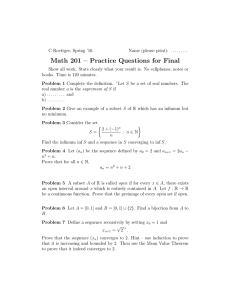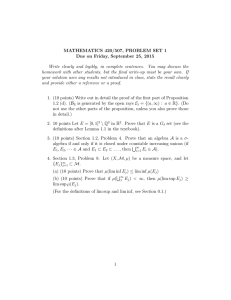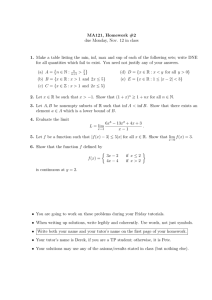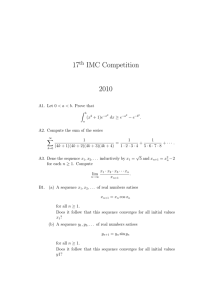Learning Celebration #1 Solutions Example (10 points)
advertisement
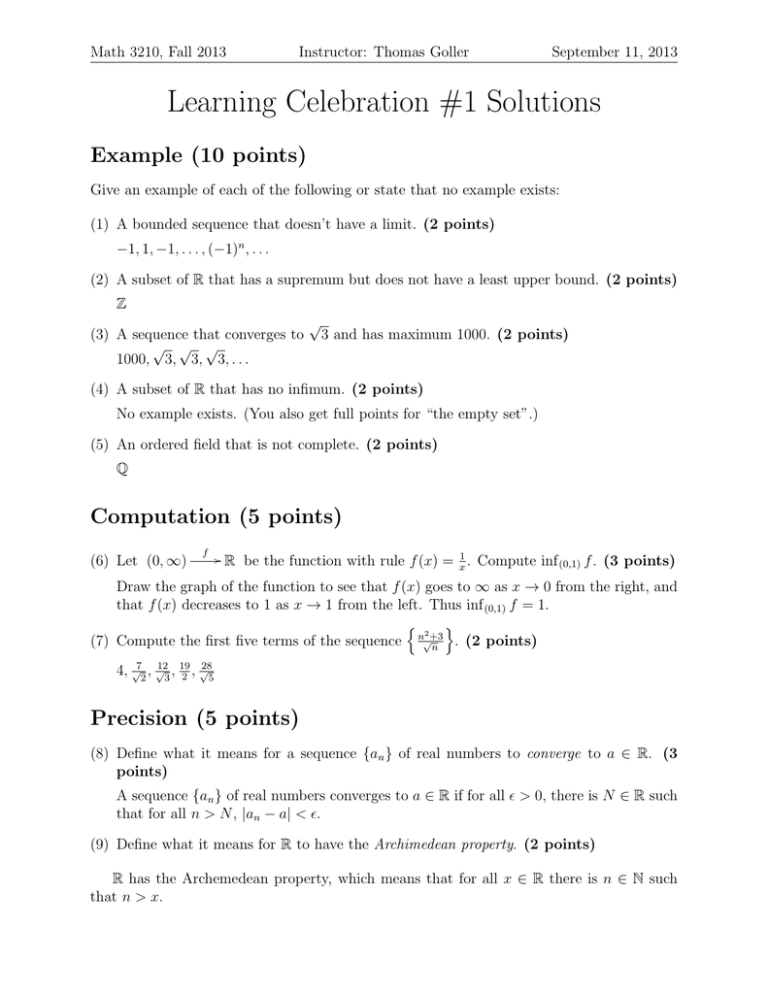
Math 3210, Fall 2013
Instructor: Thomas Goller
September 11, 2013
Learning Celebration #1 Solutions
Example (10 points)
Give an example of each of the following or state that no example exists:
(1) A bounded sequence that doesn’t have a limit. (2 points)
−1, 1, −1, . . . , (−1)n , . . .
(2) A subset of R that has a supremum but does not have a least upper bound. (2 points)
Z
(3) A sequence that converges to
√ √ √
1000, 3, 3, 3, . . .
√
3 and has maximum 1000. (2 points)
(4) A subset of R that has no infimum. (2 points)
No example exists. (You also get full points for “the empty set”.)
(5) An ordered field that is not complete. (2 points)
Q
Computation (5 points)
(6) Let (0, ∞)
f
!R
be the function with rule f (x) = x1 . Compute inf (0,1) f . (3 points)
Draw the graph of the function to see that f (x) goes to ∞ as x → 0 from the right, and
that f (x) decreases to 1 as x → 1 from the left. Thus inf (0,1) f = 1.
! 2 "
(7) Compute the first five terms of the sequence n√+3
. (2 points)
n
4, √72 , √123 , 19
, √285
2
Precision (5 points)
(8) Define what it means for a sequence {an } of real numbers to converge to a ∈ R. (3
points)
A sequence {an } of real numbers converges to a ∈ R if for all ! > 0, there is N ∈ R such
that for all n > N , |an − a| < !.
(9) Define what it means for R to have the Archimedean property. (2 points)
R has the Archemedean property, which means that for all x ∈ R there is n ∈ N such
that n > x.
Math 3210, Fall 2013
Instructor: Thomas Goller
September 11, 2013
Proof (20 points)
1
(10) Guess the limit of the sequence { n+1
}, write your guess as a claim, and prove that the
claim is correct. (5 points)
1
Claim. lim n+1
= 0.
Proof. Given ! > 0, let N = 1! . Then for all n > N ,
#
#
# 1
#
#
# = 1 < 1 < 1 = !.
−
0
#n + 1
# n+1
n
N
2n
(11) Guess the limit of the sequence { 3n−1
}, write your guess as a claim, and prove that the
claim is correct. (5 points)
2n
Claim. lim 3n−1
= 23 .
Proof. Given ! > 0, let N = 3!1 . Then for all n > N ,
#
#
# 2n
#
2
2
2
1
1
#
#
−
# 3n − 1 3 # = 9n − 3 ≤ 6n = 3n < 3N = !.
√
(12) Guess the limit of the sequence { n2 − 1 − n}, write your guess as a claim, and prove
that the claim is correct. (5 points)
√
Claim. lim n2 − 1 − n = 0.
Proof. Given ! > 0, let N = 1! . Then for all n > N ,
#
#
√
#
#
−1
1
1
1
2
#
#= √
| n − 1 − n| = # √
≤ <
= !.
#
n
N
n2 − 1 + n
n2 − 1 + n
(13) Prove that if inf A = −∞, then for each n ∈ Z there is an element an ∈ A such that
an < n. (5 points)
Proof. Let n ∈ Z be given. Since inf A = −∞, n is not a lower bound for A, so there is
an ∈ A such that an < n.
